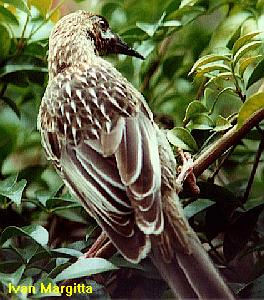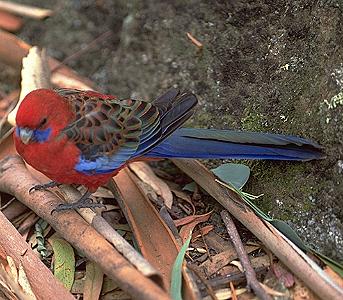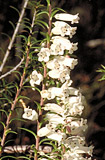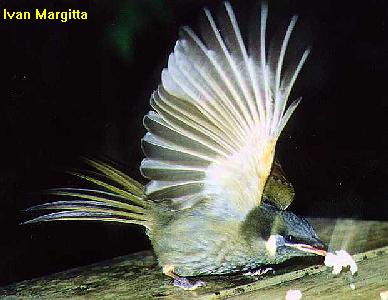|
[Front Page] [Features] [Departments] [Society Home] [Subscribe]

Birds in the Autumn Garden
John Knight
Many species of birds can be encouraged to visit the garden throughout the year, especially if you can provide the basics of life: food, water and shelter.
Water is easily provided, but sometimes we resort to artificial feeding to keep birds visiting our own patch. This practice can cause problems. Some birds become aggressively territorial, keeping many of the smaller birds from visiting. Some which are notorious for this behaviour include wattlebirds, magpies, currawongs and noisy miners. While the pleasure derived from watching a passing parade of colourful birds at a feeder is immense, we must resist putting out artificial food sources on a regular basis, lest the birds become dependent upon it. There is evidence also that by not varying their food intake, many species become less able to resist disease.
 |

|
It is possible, however, to have many visitors to your garden if you provide variety in your plantings. There is always a tendency to choose plants with the biggest, brightest flowers, or with some other attribute which we find attractive. Not often do we consider first, the needs of our avian visitors. Consideration should be given to the structure of any plantings, ensuring that protective cover is provided. This can be achieved by planting closely with ground covers and grasses, a variety of shrub sizes, and small trees. In this way birds can be encouraged first by perching high to observe their new territory, and feel secure as they move through the layers to their favoured food source.
A variety of closely planted shrubs, even away from the surrounding tree line can provide close observation of honeyeaters, finches and wrens. As these birds become confident that humans are not a threat, they tend to feed freely in more open shrubs, allowing us even better views. Birds and other wildlife give "life" to a garden, that essential element often missing in tidy, ordered exotic gardens.
|
Little Wattlebird
|
Some of the most important plants are the native grasses. These provide food for seed eating birds, and food for insects, which in turn provide food for other birds. Grasses are also important for building nests. Many grasses flower through summer. and provide a much needed source of food during late summer and autumn. as the seeds ripen. Important species. suitable for any garden. include the tussock forming plants such as Themeda australis, Kangaroo Grass. This plant is usually dormant during cool months, and begins to grow and flower late in spring, and continues to flower through to autumn, providing a reliable source of seed for birds such as Crimson Rosellas and King Parrots. These birds are also fond of Danthonia species as well as Microlaena stipoides and Entolasia stricta, particularly if these are allowed to grow uncut to maturity. Smaller birds such as finches and silvereyes also delight in feeding from these grasses, providing constant opportunities to observe them closely.
 |

|
Sedges are often overlooked when choosing plants for gardens. they do however flower and seed over a long period and many birds, both small and large, can be found enjoying the nutlike fruits. While most Gahnia species are considered too large, and due to sharp edges to their leaves, too dangerous for home gardens, they are none the less important for many seed eating birds. If you have a pond or wet area in your garden. the strong lines of Gahnia. planted behind or adjacent to the water will offer safe refuge to smaller birds, encouraging them to come to drink and bathe Other sedges include Lepidosperma species and Cyathochaeta diandra for drier sites, with Carex species and Restio tetraphyllus for damp sites adding interest around a pond.
|
Crimson Rosella
|
Smaller shrubs are important components of any garden, providing food sources at a level where birds can be easily recognised. Correa reflexa is one shrub that should be in every garden. Many forms grow to less than 1 metre and flower over a long period from March until October, offering copious nectar for honeyeaters at a time when food is scarce. Birds visiting Correa include New Holland or Yellow-winged Honeyeater, Eastern Spinebill, wattlebirds and rosellas, which are somewhat destructive of the flowers as they feed.
Similar birds are attracted to Banksia spinulosa. The smaller coastal forms begin flowering in February and continue until August. Growing to 1 metre high and about 1.5 metre across, these hardy shrubs produce long spikes of honey coloured flowers with burgundy to scarlet styles. Larger forest forms, growing to 2.5 metre, are also ideal garden plants, growing in full sun or semi-shade. All banksias require good drainage, but Banksia paludosa occurs naturally adjacent to swampy ground, and the low, heathy forms add contrast to damp areas such as near a pond. Golden flowers tinged brown are borne from April till September.
No garden can afford to be without a number of plants of Epacris impressa, Our most common form bears brilliant red tubular flowers from February, providing valuable nectar for many birds. Epacris is usually a wiry tangle of branches decorated with tightly spaced flowers. It usually grows less than I metre and can be pruned hard to encourage a compact habit if necessary. Epacris will usually flower well in full sun or semi shade. but appreciates some water during dry spells. E.impressa is also found with white flowers, and this colour form highlights the red form when they are grown together.
 |
 |
The pink form of Epacris impressa is the floral emblem of Victoria. It grows together with the white form in the Grampian Ranges.
Select the thumbnail image or highlighted name for a higher resolution image (39k and 41k).
|
 |
 |
Two members of the Protea family (Proteaceae) which produce copious nectar are Lambertia formosa (left) and Banksia spinulosa (right).
Select the thumbnail image or highlighted name for a higher resolution image (37k and 37k).
|
Larger shrubs include Grevillea arenaria, which grows to 3 metres, but can be pruned to keep it smaller. Although the plant bears small reddish green flowers for most of the sear, the casual observer rarely notices, except when the plant is alive with small birds feverishly feeding on the nectar held in large "nectaries" at the base of each flower. This is my favourite grevillea. It has pleasant grey green foliage which provides contrast to the green of other shrubs. and can be grown in full sun or semi-shade. Good drainage is essential.
Lambertia formosa is a similar sized shrub. and somewhat more difficult to establish if drainage is suspect. It is found naturally on sandstone based soils, and can be killed with kindness if too much water is available particularly it the plants are given artificial feeding as well. There is no better sight in the garden than a well grown lambertia, its open branches proudly displaying magnificent crimson or orange-red flowers and these flowers playing host to a procession of birds. Both Eastern and Crimson Rosellas are regular visitors, noisily waiting their turn at the feast. No wonder other birds defend their position as the rosellas prune the flowers off the plant to obtain nectar, leaving little for late comers. They provide a useful service just the same by tip pruning the plant saving us one job in the maintenance of this prickly plant.
In shaded sites the luminescent greenish flowers of Correa baeuerlenii are superbly highlighted. Known as the "chef cap correa", it is a shrub to 2 metre and is very hardy. The foliage is rainforest-green and exudes a wonderful fruity fragrance after rain. By providing good drainage and some water if dry, you will be rewarded with flowers from February to August and many bird visitors as well. Correa lawrenciana variety cordifolia is a much larger shrub, growing over 3 metres, but it also is a wonderful garden plant for shaded sites.
A reliable standby for every garden is Melaleuca hypericifolia, usually a dense, long flowering plant which adapts to any site be it dry or wet, sunny or shaded. Growing 3 metres or more, but easily contained with regular pruning, this melaleuca produces many reddish bottlebrush flowers from Christmas through Autumn, and at other times as well, and these are eagerly sought by many bird species.
 |

|
A couple of trees complete the picture. Banksia serrata, which grows to 8 metres, provides large flowers from Summer through Autumn. It is easily grown in well drained soils, proving long lived and reliable. The birds love it. Less commonly grown is Allocasuarina littoralis, a similar sized but less dominant tree. Also growing to around 8 metres, and very adaptable, it produces lovely seed cones which are attractive to a range of bigger beaked birds such as parrots and cockatoos. It is necessary to plant more than one plant, as male and female flowers are borne on separate. A group of five, randomly spaced provides a shady nook in which to relax as you watch the birds go about their daily lives.
|
Levin's Honeyeater
|
Many birds are insect eaters, or obtain much of their protein requirements from insects. With a garden which includes the plants mentioned, insects will also be attracted, and these in turn attract Robins, Flycatchers and Wrens.
If your garden is a forlorn patch of paspalum, do not despair. If allowed to seed rather than mown regularly, you can still be rewarded with visits from squabbling Galahs and rosellas, arguing over who has the rights to the bounty.
From the newsletter of the South East New South Wales Group of the Australian Plants Society.
John is the Superintendent of the Eurobodalla Native Garden at Batemans Bay on the south coast of New South Wales. Most of the plants discussed by John in this article are those which occur in the south coast region. The principles, however, apply generally.
Special thanks to Ivan Margitta for the photos of Levin's Honeyeater and the Little Wattlebird

[Front Page] [Features] [Departments] [Society Home] [Subscribe]
Australian Plants online - March 2000
Association of Societies for Growing Australian Plants
|